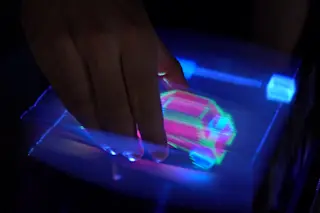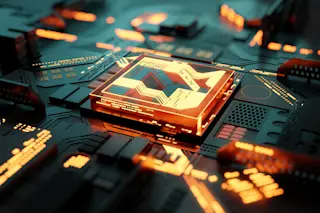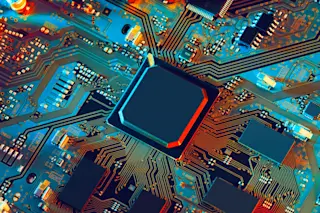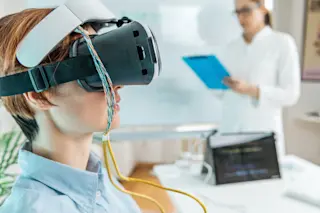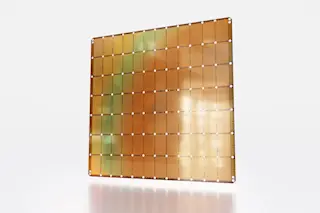Imagine a world where two-dimensional data could be moved and manipulated in a three-dimensional setting. In the hospital room, for example, a doctor may visually see, manipulate, and experience a patient’s MRI brain scan, or a building engineer may project newly designed infrastructure so investors can walk through blueprints.
Rather than simply viewing two-dimensional data or information on a screen, a user can interact directly with an object, spin it around, and better visualize it in its full structure.
“We’re in a world now where there is an enormous amount of 3D data, yet there are presently only a limited number of ways to look at it,” says Michael Bove, a freelance researcher and inventor of 3D displays who frequently works with MIT.
Hologram vs. Volumetric Displays
Two modern technologies promise to provide just that: volumetric displays and holograms. Although the two terms are commonly used interchangeably, they are very different technologies, says Bove.
“A hologram is something that uses diffraction to create a light field in the air, while a volumetric display has points of light in the air, usually by having a mechanical device with either a moving screen to project on or an array of LEDs that moves up and down in space,” says Bove.
By shining a fine diffraction pattern, a hologram creates a light field in space and shows three-dimensional images similar to seeing those through a window. Volumetric displays, however, show points of light coming from every position within a volume to render three-dimensional images that can be directly observed.
“What we see in movies, and is called a hologram, is more accurately a volumetric display,” says computer scientist Asier Marzo.
Read More: Research Into Holograms Could Improve Forensic Fingerprint Analysis
Manipulating 3D Graphics
Marzo is the co-author of a new study that, for the first time, describes volumetric displays — colloquially referred to as holograms — that display three-dimensional graphics in mid-air that users can manipulate in real time.
Volumetric displays use a fast oscillating sheet known as a diffuser that synchronously projects nearly 3,000 images per second. These individual images create an entire “volume,” or display. However, optical diffusers are usually rigid and do not “allow for direct interaction,” according to researchers.
“The diffuser of a volumetric display bounces the projected light; it is the projection screen where the graphics are seen. This diffuser oscillates very quickly, and due to persistence of vision, the graphics appear in a volume,” says Marzo.
“An elastic diffuser can be deformed and return to its original shape, so if the hands get inside the volume where it oscillates, the diffuser will deform around the hand without damaging it, and return to its original shape when the hand is removed.”
Since the diffuser is cut into strips and oscillates at high speed, it does not entangle around the fingers, even when the hand glides through.
The new technology, FlexiVol, employs elastic diffusers that allow users to directly interact with “true” three-dimensional content inside the display volume. Graphics in FlexiVol provide the depth cues of real objects through binocular disparity (different images for each eye) and focus accommodation (blurred view of what is not in focus).
“Without having to wear devices, true 3D content appears like volumetric displays projected in mid-air that can be observed by multiple people from different angles,” says Marzo.
Pushing Boundaries with FlexiVol
Users don’t literally grab the three-dimensional object, but the effect is given through an imaging technique. The device detects where a person’s fingers are and anticipates their movements, adapting to what the person is doing.
“It’s natural to see an object in space and want to reach out and grab it. This technology lets you do that,” says Bove, who was not involved in the study. “But it’s not the same as if you’re holding something and moving it around.”
And because there is no need for special glasses or a headset, FlexiVol provides a shared experience between people, further pushing the boundaries of scientific innovation. Surgical visualization or structural engineering are just two fields that may employ the technology in a commercial or learning environment.
Then again, Bove adds that volumetric displays are “just fun” and can be used in the entertainment industry, from films to video games.
FlexiVol and other technologies like it use a gestural interface, meaning a person can go in and “poke” it and move some things around, but they don't necessarily feel anything. A haptic interface, on the other hand, allows a person to feel something when they put their hand into the display, and that’s not traditionally compatible with a volumetric display.
Marzo says his team plans to add tactile sensations so that the user “feels” temperature or pressure when interacting with the volumetric display, and allow larger displays to be reachable from the sides and the top.
Read More: Hopeful Scientists Bring Holograms to Life
Article Sources
Our writers at Discovermagazine.com use peer-reviewed studies and high-quality sources for our articles, and our editors review for scientific accuracy and editorial standards. Review the sources used below for this article:
CHI '25: Proceedings of the 2025 CHI Conference on Human Factors in Computing Systems. FlexiVol: a Volumetric Display with an Elastic Diffuser to Enable Reach-Through Interaction



